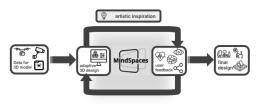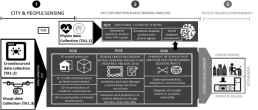Objectives
Artists and technology experts will closely collaborate under a novel working model scheme to propose innovative designs to address societal challenges faced by cities as they expand, and the evolving needs in functionality and emotional resonance of modern day workplace and housing interiors1. Art has the capacity to transcend established theoretical and conceptual frames and act in cross-disciplinary ways, as it provides space for what is called as“lateral” thinking, that is to address issues with an ‘out of the box’ approach. Collaborations between artists and scientists or technologists fall into the realm of techno science art, which has a long history of experimentation and impact on research and design. Artists will help create AR/VR installations that will highlight the cultural significance of cities and sustainability issues they are facing, as well as paradigm-shifting designs of indoors work and living environments. Their aim will be to ensure improved functionality, usability, but also emotional and cognitive wellbeing of end users. State-of-the-Art (SoA) multisensing technology, such as wearable EEG, physiological sensing, visual analysis, social media inputs, will be integrated for the immediate assessment of innate user responses to the MindSpaces installations, and artistic adaptation of the designs accordingly.
The central objective of MindSpaces is to create the tools and develop the solutions for adaptive and inclusive spaces that dynamically adapt to emotional, aesthetical and societal responses of end users, creating functionally and emotionally appealing architectural design.
In order to involve and collaborate with the most appropriate and wide range of artists and leverage multiple sources of inspiration and interdisciplinary collaboration, MindSpaces will create Open Calls to artists, with a specific budget allocated for this purpose. As a result, artist residencies will be made possible beyond the project applications in architecture, expanding its artistic and societal impact, as well as its exploitability in numerous sectors. The consortium includes digital artists Maurice Benayoun and Refik Anadol, with a distinguished career of involvement in large-scale architecture, public/urban and socially-sensitive art, and Espronceda, a program that provides artistic residencies in Barcelona, Spain. Maurice and Refik are not traditional “pure” artists as they have a long career of involvement in public art spaces, in which they have systematically used the most innovative future oriented technologies and recognized internationally by Ars Electronica. Tobias Klein, an artist and architect, and Jean-Baptiste Barrière, artist and composer, working with Maurice Benayoun on his Brain Factory and Brain Cloudprojects, will continue their collaboration with him and Refik within MindSpaces. They are all eminently suited to collaborate in this project under a common working model scheme and will leverage their extensive networks to organize Open Calls to other artists, experienced or emerging. In collaboration with Espronceda, in Barcelona, nearone of the project use case locations (City de L’Hospitalet), they will set up a committee combining the partnersand external art institutions to invite artists to MindSpaces artistic residencies, where their collaboration is expected to help attain the project goals.
The central concept and flow of MindSpaces can be seen in Figure 1 below. Original 3D models of spaces to be developed by architects and artists and will be used as a basis to propose innovative, art-inspired outdoors environments for a city, indoors workspace and house re-design. The design ideas will be integrated artistically in AR/VR environments, which will be modified in real time in response to EEG, physiological (heart rate, galvanic skin response) and environmental (presence sensing, video monitoring) measurements of end users. This will leadto adaptive designs that immediately respond to users’ emotional, functional needs, resulting in improved, attractive city spaces, inspiring and productive work environments and functional home interiors.

Background
The design of space, on architectural and urban scales has been shown to significantly affect the emotional, cognitive wellbeing of individuals, and to influence the functionality and effectiveness of indoors and outdoors spaces in manners that have often been overlooked in the past2,3. In recent years, advances in cognitive science, in sensing technologies and in the arts and creative industries have been paving the way for deeper understanding ofthe effects of environments on individuals’ wellbeing and behavior.
MindSpaces will bring together artists, creatives and technology experts to produce AR/VR installations representing emotionally and functionally adaptive designs of outdoors and indoors spaces. Innovative design ideas will be introduced by art practices, through their ability to imagine futures that do not just reflect the current consensus in mathematics, logic and engineering, setting into motion new ways of seeing, hearing, touching, feeling, transforming and experiencing spaces, places and community. Emotional, cognitive, behavioral measurements will provide insights into the effects of proposed designs on end users. Artists will incorporate theseresponses into “living” installations, adapting them online to elicit positive emotional and behavioral feedback.
This proposal is at the vanguard of a new wave of designers, architects and engineers that affirm the necessity of an interdisciplinary approach that integrates novel technologies to inform design. By integrating approaches from neuroscience, physiology and psychology with architectural research, sociological and ethnographic methodologies, human experience can be directly linked to design by correlating specific measures of the builtenvironment (input) with quantified measures of the brain’s and body’s responses (neural, physiological andpsychological responses), as well as sociological, behavioral and economic outcomes (output). Using neuroscientific tools objective measurements can now be used along with traditional subjective evaluations. These results and a more encompassing framework in which also there is a better chance to address the needs and preferences of various special populations with physical or psychological impairments.

